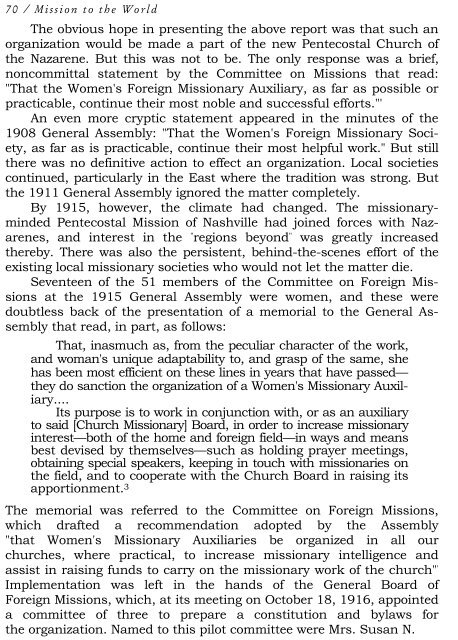The Nazarene World Mission Society
The Nazarene World Mission Society
The Nazarene World Mission Society
Create successful ePaper yourself
Turn your PDF publications into a flip-book with our unique Google optimized e-Paper software.
70 / <strong>Mission</strong> to the <strong>World</strong><strong>The</strong> obvious hope in presenting the above report was that such anorganization would be made a part of the new Pentecostal Church ofthe <strong>Nazarene</strong>. But this was not to be. <strong>The</strong> only response was a brief,noncommittal statement by the Committee on <strong>Mission</strong>s that read:"That the Women's Foreign <strong>Mission</strong>ary Auxiliary, as far as possible orpracticable, continue their most noble and successful efforts."'An even more cryptic statement appeared in the minutes of the1908 General Assembly: "That the Women's Foreign <strong>Mission</strong>ary <strong>Society</strong>,as far as is practicable, continue their most helpful work." But stillthere was no definitive action to effect an organization. Local societiescontinued, particularly in the East where the tradition was strong. Butthe 1911 General Assembly ignored the matter completely.By 1915, however, the climate had changed. <strong>The</strong> missionarymindedPentecostal <strong>Mission</strong> of Nashville had joined forces with <strong>Nazarene</strong>s,and interest in the " regions beyond " was greatly increasedthereby. <strong>The</strong>re was also the persistent, behind-the-scenes effort of theexisting local missionary societies who would not let the matter die.Seventeen of the 51 members of the Committee on Foreign <strong>Mission</strong>sat the 1915 General Assembly were women, and these weredoubtless back of the presentation of a memorial to the General Assemblythat read, in part, as follows:That, inasmuch as, from the peculiar character of the work,and woman's unique adaptability to, and grasp of the same, shehas been most efficient on these lines in years that have passed—they do sanction the organization of a Women's <strong>Mission</strong>ary Auxiliary....Its purpose is to work in conjunction with, or as an auxiliaryto said [Church <strong>Mission</strong>ary] Board, in order to increase missionaryinterest—both of the home and foreign field—in ways and meansbest devised by themselves—such as holding prayer meetings,obtaining special speakers, keeping in touch with missionaries onthe field, and to cooperate with the Church Board in raising itsapportionment. 3<strong>The</strong> memorial was referred to the Committee on Foreign <strong>Mission</strong>s,which drafted a recommendation adopted by the Assembly"that Women's <strong>Mission</strong>ary Auxiliaries be organized in all ourchurches, where practical, to increase missionary intelligence andassist in raising funds to carry on the missionary work of the church" 'Implementation was left in the hands of the General Board ofForeign <strong>Mission</strong>s, which, at its meeting on October 18, 1916, appointeda committee of three to prepare a constitution and bylaws forthe organization. Named to this pilot committee were Mrs. Susan N.
















